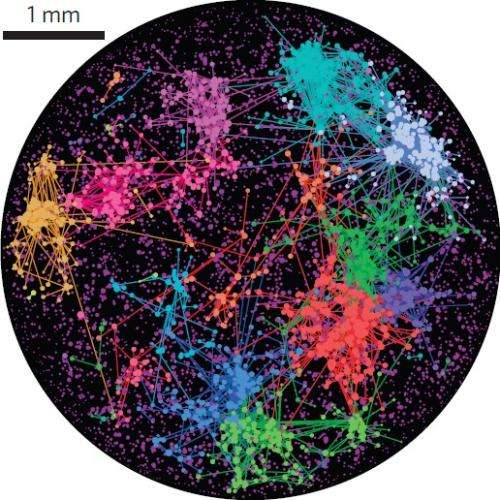August 26, 2013 feature
How does complex behavior spontaneously emerge in the brain?

(Phys.org) —The idea of emergence, in which complex behavior spontaneously emerges out of simple interactions, exists in a wide variety of areas, such as economics, the Internet, and urban development. But perhaps the ultimate example of emergence is in the brain, where thousands of randomly firing neurons spontaneously reach a coherent state of collective, periodic firing that underlies all brain functions. Despite significant progress, the mechanisms responsible for the origin and maintenance of spontaneous neuronal activity are still poorly understood.
In a new study published in Nature Physics, a team of researchers from Spain has shown that emergence in neuronal networks can be explained as a noise-driven phenomenon that is controlled by the interplay between network topology and intrinsic neuronal dynamics. In this scenario, a randomly fired pulse propagates through the network and is amplified by noise focusing, which the researchers describe as an implosive concentration of spontaneous activity.
"From the experimental point of view, we show that in neuronal cultures, the emergence early in the development of collective spontaneous activity is dominated by the presence of activity waves that initiate in specific regions of the culture, in a similar way as it happens in vivo," lead author Javier G. Orlandi at the University of Barcelona told Phys.org. "And with the help of simulations, we also show that you don't need any special mechanism to explain this behavior, just the right combination of network structure and dynamics. These waves emerge naturally from the noise focusing effect, in which individual firings propagate and concentrate in specific regions to later generate these activity waves."
The researchers arrived at this explanation by combining high-resolution calcium imaging experiments of rat cortical neurons with simulations. The experiments revealed that bursts of neuronal pulses are controlled by waves that originate at small areas called nucleation sites.
Although previous research has hinted at the existence of such waves, this study is the first that provides sufficiently high resolution to measure the wave velocity for the first time. The random nature of the wave initiation from spontaneous neuronal firing also supports the idea that it is a noise-driven phenomenon, in which the waves are later amplified to become global bursts.
The view of emergence in neural networks as a noise-driven phenomenon differs from the common view in which the bursts of neuronal pulses are controlled by specific leader neurons assisted by the network architecture. In the noise-driven explanation, the nucleation sites do not actively initiate the firing process, but collect and amplify the firing activity that originated elsewhere.
As the researchers explain, understanding the full implications of noise focusing in the brain remains a question for future research.
"The mechanism of noise focusing emerges naturally in any system with interconnected integrate-and-fire units (like neurons), so its effect should also be present in the brain," Orlandi said. "If this effect is important in the brain, or by contrast, if the brain has other mechanisms to counter its effect, is still an open question. It could be that noise focusing is responsible for the generation of waves of activity during development, like in the retina, and that it helps the maturation of specific neuronal pathways."
In the future, the researchers plan to further investigate neuronal activity through more in-depth investigations.
"We want to see what happens in more complex neuronal systems, like slices or electrode recordings from anaesthetized animals, and see if we find the same effect in there," Orlandi said. "We know that activity waves are present in these systems, but we still need to see how these waves form exactly, if it is also due to noise focusing or due to something else. It would also be extremely interesting to check what role noise focusing plays in social networks, for example in rumor spreading."
In this analogy, the points of a rumor's origins can be compared to the nucleation sites where waves originate, and the spreading of a rumor to the brain's collective neuronal firing.
More information: Javier G. Orlandi, et al. "Noise focusing and the emergence of coherent activity in neuronal cultures." Nature Physics. DOI: 10.1038/NPHYS2686
Journal information: Nature Physics
© 2013 Phys.org. All rights reserved.


















